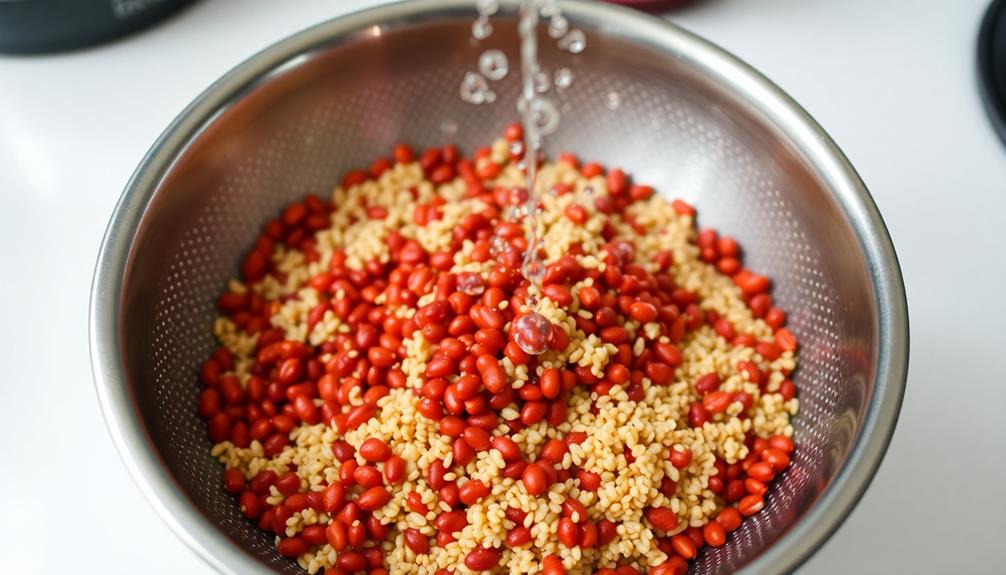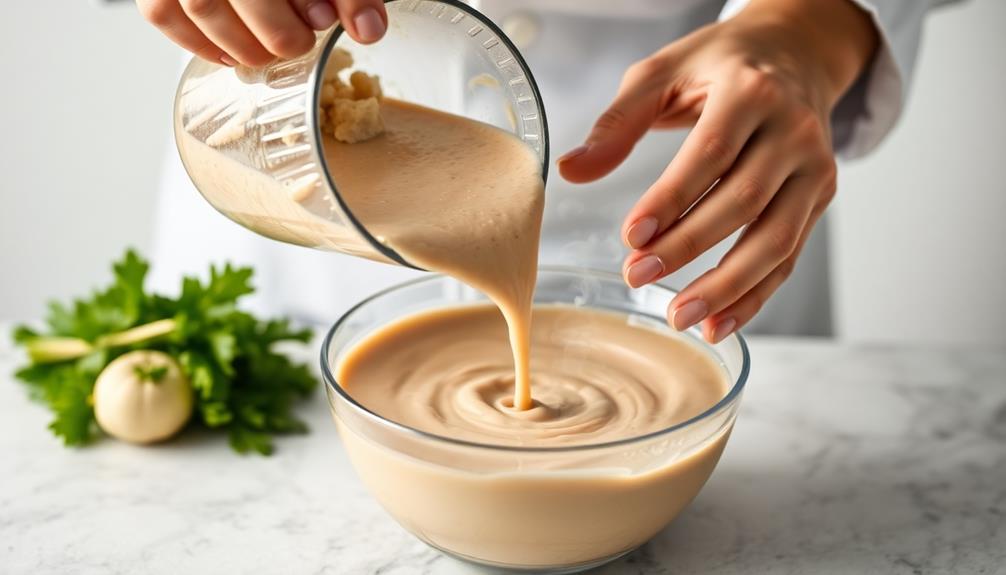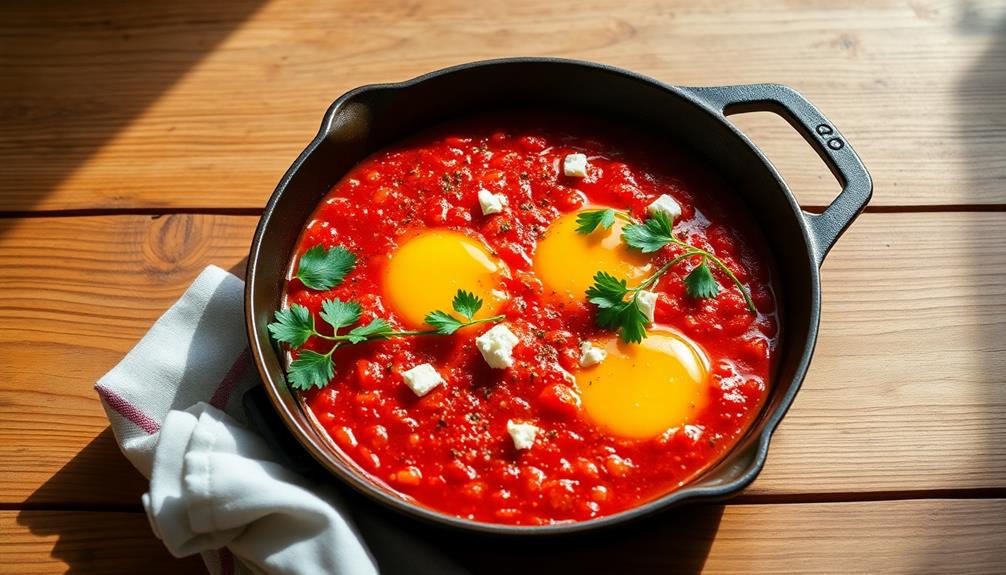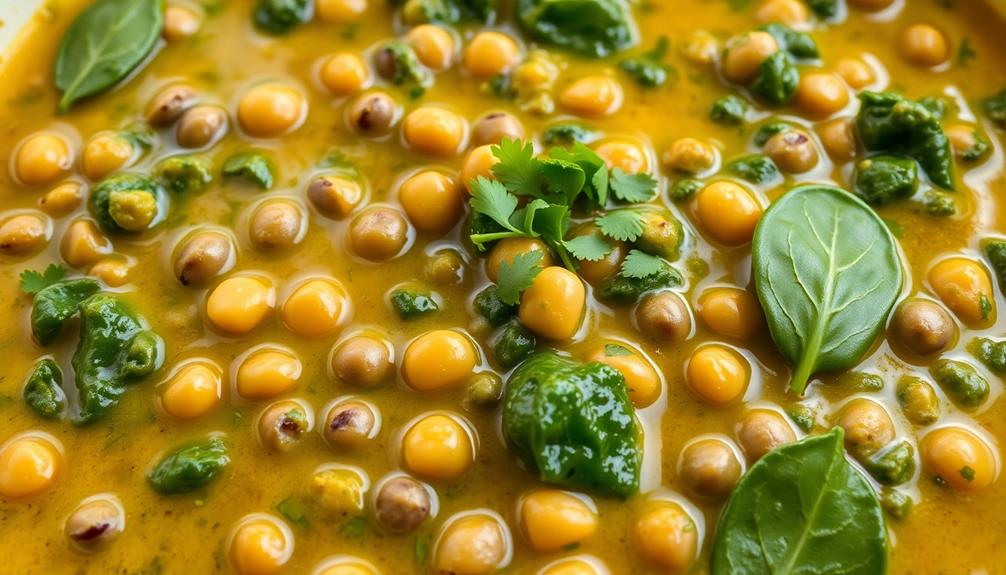Forget everything you know about tofu – the world of plant-based proteins is bursting with delightful and nutritious surprises! From hearty lentils to nutty quinoa, these alternatives offer complete protein profiles to fuel your body. You can even find creative 'meats' made from peas or mycoprotein. Dig into these mouthwatering dishes, where spices, herbs, and cooking techniques transform simple ingredients into culinary masterpieces. Prepare to be amazed as you uncover the endless possibilities of plant-based eating – your taste buds and overall health are in for a delightful treat. Intrigued? Keep reading to discover the captivating evolution and future of these sustainable protein sources.
Key Takeaways
- Alternative plant-based proteins have evolved beyond traditional soy-based options, now encompassing a diverse range of ingredients like peas, lentils, and mycoprotein.
- These alternatives offer complete protein profiles, essential vitamins, minerals, and fiber, supporting overall health and well-being.
- Innovative cooking techniques, such as soaking, blending, and seasoning, enhance the texture and flavor of plant-based dishes.
- Increased consumer demand for sustainable and ethical food choices is driving the growth and development of a wide variety of plant-based meat substitutes.
- Technological advancements in food science are improving the quality, taste, and nutritional value of plant-based proteins, shaping a promising future for this sector.
History
The emergence of alternative plant-based proteins can be traced back to the late 19th century, as a response to the growing demand for more sustainable and ethical food sources. During this time, researchers and pioneers began exploring innovative ways to create protein-rich products from plants. One of the earliest examples was the development of soy-based "meat" in the 1860s, which aimed to provide a more environmentally friendly alternative to traditional animal-based proteins.
As the 20th century progressed, the plant-based protein movement gained momentum. Food scientists continued to refine and expand the range of options, from textured vegetable proteins to wheat-based seitan. These alternatives appealed to vegetarians, vegans, and those seeking healthier, more sustainable dietary choices.
Today, the market for plant-based proteins has exploded, with a wide array of innovative products made from sources like peas, lentils, and even mycoprotein, a fungus-derived ingredient. The evolution of alternative plant-based proteins reflects the growing desire for diverse, eco-friendly food solutions.
Recipe
Recipe
Lentils and quinoa are powerhouse ingredients when it comes to plant-based proteins. This hearty and nutritious bowl combines the two for a complete protein meal that's both satisfying and delicious. The earthy flavors of the lentils pair perfectly with the nutty quinoa, making this dish a versatile option for a main course or a side.
Additionally, this protein-rich dish is low in calories and high in fiber, promoting digestive health while aligning with the benefits of a vegetarian diet.
This recipe is easy to prepare and can be customized to suit your taste preferences. Feel free to add your favorite vegetables, herbs, or condiments to enhance the flavors further.
Ingredients:
- 1 cup dried lentils, rinsed
- 1 cup quinoa, rinsed
- 4 cups vegetable broth
- 1 teaspoon ground cumin
- 1 teaspoon smoked paprika
- 1/2 teaspoon garlic powder
- 1/4 teaspoon cayenne pepper (optional)
- Salt and pepper to taste
Instructions:
In a large saucepan, combine the lentils, quinoa, and vegetable broth. Bring the mixture to a boil over high heat.
Reduce the heat to low, cover the pan, and simmer for 20-25 minutes, or until the lentils and quinoa are tender and the liquid has been absorbed.
Remove the pan from the heat and stir in the cumin, smoked paprika, garlic powder, and cayenne pepper (if using). Season with salt and pepper to taste. Fluff the mixture with a fork and serve warm.
Tips:
- For a creamier texture, stir in a tablespoon or two of unsweetened almond or cashew milk after cooking.
- Top the protein bowl with your favorite toppings, such as diced avocado, roasted vegetables, or a drizzle of tahini sauce.
- This dish can be made in advance and stored in the refrigerator for up to 4 days. Reheat before serving.
Cooking Steps
First, you'll need to soak the [Placeholder] in water overnight.
Then, drain and rinse the [Placeholder] before blending it into a smooth paste.
Finally, cook the [Placeholder] in a skillet and season it with your favorite spices.
Get ready to create a delicious plant-based dish!
Step 1. Soak [Placeholder] in Water Overnight

Before you begin cooking, it's important to properly soak the [placeholder] overnight. This simple step helps to soften the [placeholder], making them easier to cook and digest.
Fill a large bowl with clean water and add the [placeholder]. Make sure the [placeholder] are fully submerged. Cover the bowl and let it sit at room temperature for at least 8 hours, or overnight. This allows the [placeholder] to absorb the water, expanding in size and becoming more tender.
Once the soaking time is up, drain the [placeholder] in a colander. Rinse them under fresh running water to remove any excess starch or debris.
Now you're ready to move on to the next steps in the recipe. Soaking the [placeholder] is a simple but crucial preparation that will help you achieve the best texture and flavor in your plant-based dish.
Step 2. Drain and Rinse [Placeholder]

Draining and rinsing the soaked [placeholder] is a crucial step in the cooking process. After letting it soak overnight, you'll want to carefully drain the water from the [placeholder].
Place a colander or strainer in the sink and gently pour the [placeholder] into it. This allows the excess water to flow out, leaving you with the plump, rehydrated [placeholder] ready for the next steps.
Once drained, give the [placeholder] a quick rinse under cool running water. This helps remove any lingering dirt, debris or impurities.
Gently stir the [placeholder] with your hands as the water runs through, ensuring every piece is thoroughly cleaned. Drain it again, shaking the colander lightly to remove any remaining droplets.
Your [placeholder] is now prepped and primed for flavorful cooking! The soaking and rinsing process may seem simple, but it's an essential foundation for unlocking the full deliciousness of this plant-based protein.
Step 3. Blend [Placeholder] Into a Smooth Paste

With your [placeholder] now drained and rinsed, you can move on to blending it into a smooth paste. This step is crucial for creating a consistent texture in your plant-based dish.
Grab your blender or food processor and add the [placeholder]. Start on a low speed and gradually increase the power, blending until the mixture reaches a smooth, creamy consistency.
Be sure to scrape down the sides of the container as needed to ensure even blending. The key is to blend for long enough to break down the [placeholder] into a uniform paste, without over-processing and creating a liquefied mixture.
Once you've achieved the desired texture, your [placeholder] paste is ready to be incorporated into the rest of your recipe. This flavorful base will add depth and richness to your plant-based creation.
Step 4. Cook [Placeholder] in a Skillet

Next, heat a skillet over medium heat. Once it's warm, add a touch of oil and let it heat up.
Now, carefully place your [Placeholder] into the skillet. Listen as it sizzles – that's the sound of deliciousness in the making! Gently move the [Placeholder] around the pan, making sure each side gets a chance to brown.
You'll know it's ready when it starts to develop a nice, crispy texture. Don't be afraid to let it get a little golden brown – that's where the flavor really shines.
As it cooks, the aromas will fill your kitchen, making your mouth water. Keep an eye on it, flipping and stirring occasionally, until the [Placeholder] is cooked through.
Now, you're ready to enjoy your tasty [Placeholder] creation! Serve it up hot, maybe with a side of your favorite veggies or a crisp salad. Yum!
Step 5. Season [Placeholder] With Spices

To season your [Placeholder], gather an assortment of your favorite spices.
Maybe you love the warmth of garlic powder, the earthy notes of cumin, or the zesty kick of chili powder. Experiment and find the blend that tantalizes your taste buds.
Sprinkle the spices generously over the [Placeholder], making sure to coat all sides evenly. Rub them in with your fingertips to help the flavors really sink in.
As the [Placeholder] sizzles in the skillet, the aroma of the spices will fill your kitchen, getting your mouth watering in anticipation.
Don't be afraid to add a little extra spice if you like it bold. The key is to balance the flavors to your liking.
With a few shakes and a sprinkle, you can transform your [Placeholder] into a flavor-packed masterpiece.
Get creative and have fun seasoning!
Final Thoughts
Alternative plant-based proteins hold immense potential to reshape the global food landscape. As we've explored, these innovative options can provide delicious and nutritious alternatives to traditional animal-based proteins.
For instance, incorporating nutrient-dense ingredients like chia seeds and digestive health can enhance the overall nutritional profile of plant-based meals. Whether you're a seasoned vegetarian or simply looking to add more variety to your diet, the future of plant-based eating is bright.
The possibilities are truly endless. From mouthwatering meat substitutes to creative legume-based dishes, the world of alternative proteins offers a boundless array of flavors and textures to discover. And with the rise of techniques such as aquafaba magic, which uses the brine from canned chickpeas as a versatile plant-based egg substitute, the options for creating delicious and satisfying plant-based meals are constantly expanding. Whether you’re looking to recreate your favorite comfort foods without meat or exploring new culinary frontiers, the world of alternative proteins has something for everyone to savor. So why not embark on a journey of discovering new and exciting flavors with these innovative and sustainable ingredients?
As consumer demand and technological advancements continue to drive progress, we can expect to see even more exciting developments in this rapidly evolving field.
Frequently Asked Questions
What Are the Nutritional Benefits of Alternative Plant-Based Proteins?
Alternative plant-based proteins offer a range of nutritional benefits. They're packed with protein, fiber, and essential vitamins and minerals, making them a healthy, sustainable choice for your diet. Plus, they're versatile and easy to incorporate into your meals.
How Do Alternative Plant-Based Proteins Compare to Traditional Meat in Terms of Taste and Texture?
Alternative plant-based proteins can offer a similar taste and texture to traditional meat, but the experience varies. Some mimic the experience closely, while others have their own distinct flavors and mouthfeels that may take some getting used to.
Are Alternative Plant-Based Proteins Suitable for People With Food Allergies or Dietary Restrictions?
Alternative plant-based proteins can be suitable for people with food allergies or dietary restrictions, as many are free from common allergens like dairy, eggs, and gluten. You'll want to check the ingredients carefully to find options that meet your specific dietary needs.
How Do the Environmental Impacts of Alternative Plant-Based Proteins Differ From Traditional Meat?
The environmental impacts of alternative plant-based proteins are generally lower than traditional meat. They use less land, water, and emit fewer greenhouse gases, making them a more sustainable option for eco-conscious consumers.
What Is the Cost Difference Between Alternative Plant-Based Proteins and Traditional Meat?
Generally, alternative plant-based proteins cost more than traditional meat due to the processing and specialized ingredients required. However, the environmental benefits of plant-based options may offset the higher price for some consumers.










